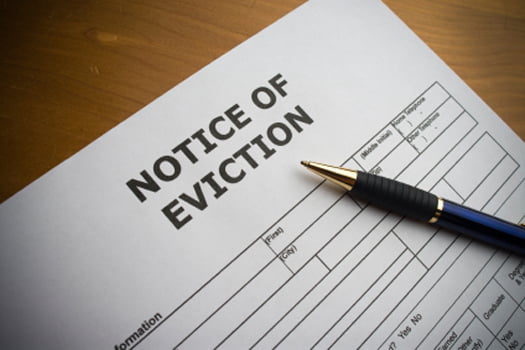Renters across California came home to an early Christmas present from their landlords this season: a 60-day notice to vacate.
Reports of sudden eviction drives are emerging throughout the state, spurred on by AB 1482’s effective date of January 1, 2020. The new law caps annual rent increases in California at 5% plus inflation through January 1, 2030. Separately, the law requires landlords to show just cause for evicting a tenant when the renter has occupied the unit for 12 months.
The Legal Aid Society of San Mateo County reports that these mass eviction notices spiked 200% in the 30 days after AB 1482 was passed In September 2019.
Editor’s note — Download RPI Form 569-1 to review the proper use and terms of a 60-day notice to vacate.
Down the loophole
Sounds like a good deal for renters, right? Well, legislators neglected to account for a little loophole in the law caused by Costa Hawkins. This controlling precedent allows landlords to reset their rent-controlled apartments to market rent whenever a tenant moves out.
So how are landlords taking advantage of this oversight? Technically, a landlord may serve a tenant a no-fault eviction notice — say, their unit is undergoing a substantial renovation — and then hike up the rent afterward. Because service of a 60-day notice to vacate is required, the last day to take advantage of this loophole was October 31, 2019.
Editor’s note — Property managers and DRE licensees alike can refresh their knowledge to ensure compliance with the latest state and federal housing laws using first tuesday’s Landlords, Tenants and Property Management 45-hour Continuing Education package.
Related article:
This workaround leaves California tenants in the very situation AB 1482 was intended to prevent. Even long-time tenants are being forced to choose between accepting huge rent hikes and moving out after being served an eviction notice.
The recent rash of 60-day notices has prompted some cities to issue emergency moratoriums on evictions as a stop-gap until AB 1482’s effective date. The following California cities have passed such moratoriums or similar provisions to protect tenants until AB 1482’s effective date:
- Bell Gardens;
- Daly City;
- Long Beach;
- Los Angeles;
- Milpitas;
- Pasadena;
- Pomona;
- Redwood City;
- San Mateo;
- Santa Cruz; and
- South Pasadena.
Editor’s note — Have you been served a 60-day notice? Tenant group Tenants Together publishes a tenant advocacy tool kit to enforce your rights.
Double take
These moratoriums are a direct response to local tenant group objections. They characterize loophole evictions as unconscionable. In many situations, families occupying rent-controlled units are wondering where they’ll sleep come January 1 after being forced out — some after more than ten years of residency.
With over half of California’s renters cost burdened, this scenario is not uncommon as rent-controlled units house some of the state’s most vulnerable residents.
Some landlord groups are less sympathetic, contending that this “loophole” is a legitimate practice. After all, what incentive do landlords have to play nice and let others reap the rewards of bungled legislation? Barring local moratoriums, some landlords consider this playbook fair game.
That’s not to say all landlords are taking advantage of preemptive no-fault evictions. The number of AB-1482 evictions is unknown, but they have been reported in such significant volume that they paint a crystal-clear picture; a sudden rush of evictions on this scale doesn’t happen apropos of nothing, after all.
This is just the first of many issues plaguing rent-control policies. While it may protect some tenants at first, AB 1482 is a band-aid solution to a long-term problem. Click through for a first tuesday proposal to replace rent control with more common-sense housing production policies.
Related article:
Change the law: Eliminate rent control in favor of more low-income housing
Agents and brokers — with the rental market in a death grip, is there any breathing room for compassion in real estate? Or have legislators forced the hand of landlords? Leave your thoughts in the comments below.















The Liberals crying about a shortage of housing are the exact same people who support Sanctuary Cities, a Sanctuary State, want to legalize illegal aliens etc. They are causing the problem which they are complaining about. Enforce the law, deport the millions of illegal aliens, free up all that housing for American citizens and legal immigrants.
Tim you offer no solutions, only childish complaints. These are serious problems that require thoughtful discussion and not just simple minded spiteful criticism of “libs,” etc. Grow up buddy.
I believe we can all agree rent control is an ill intended fix to a real problem of affordability and housing at large. Let’s focus on how to address the issue. Let those who disagree make their arguments and let us respond to them with facts, evidence and reason. I believe we can prevail in the market of ideas if we are serious about it and genuinely make serious arguments as to why rent control is a disservice to communities and rental units at large.
May the best ideas prevail.
Israel Hernández you appear to know much about this subject. Other then enpty words, what is your solution? I see no facts in your post.
RIGHT ON!
Rent control is not an answer to the problems. Supply is short and building approvals are costly and time consuming. We need more housing supply, more quickly which will allow more affordability.
5% plus the annual inflation. So, if rent is $1,500, they can move it each year by a minimum of first year of $75, then minimum of $78. I don’t see this as a good deal for tenants at all regardless of the AB 1482. counties should have their own maximums or overlay laws.